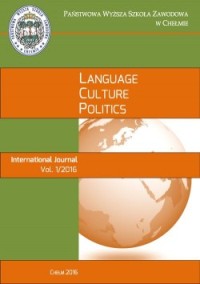LANGUAGE AND CULTURE: A VIEW FROM CATEGORIZATION STUDIES. QUESTION: WHAT ARE PARADIGMATIC THESES IN LINGUISTICS?
LANGUAGE AND CULTURE: A VIEW FROM CATEGORIZATION STUDIES. QUESTION: WHAT ARE PARADIGMATIC THESES IN LINGUISTICS?
Author(s): Vasyl StarkoSubject(s): Theoretical Linguistics, Applied Linguistics
Published by: Instytut Neofilologii, Państwowa Wyższa Szkoła Zawodowa w Chełmie
Keywords: cognitive linguistics; categorization; culture; color concept; color term; exemplar; blue.
Summary/Abstract: The interrelationship between language and culture is at the heart of linguistics and is reflected in its paradigmatic theses. The cognitive linguistic approach is to acknowledge that culture-specific color concepts mediate color perception in a given culture and language and should be explicated from the natives’ point of view. The main principle of color categorization is reference to exemplars, which may be explicit (e.g. navy blue) or implicit (red referring to blood and fire). Common referential exemplars are salient features of the environment (sky, vegetation, earth, etc.) and the human body. An analysis of the Ukrainian three color names for blue – synii ‘blue, dark blue’, blakytnyi ‘sky-blue’ and holubyi ‘light blue’ – reveals the intricate ways in which this general mechanism may function. Color categorization is an area where a number of factors – genetic, neurophysiological, perceptual, cognitive, linguistic and, importantly, cultural – interact and overlap. Linguistic color categories emerge from people’s interaction with the environment and are shaped by a specific linguistic-cultural tradition. The two-system model of color categorization recognizes that linguistic color concepts override perceptual color impressions.
Journal: Language, Culture, Politics. International Journal
- Issue Year: 1/2016
- Issue No: 1
- Page Range: 59-67
- Page Count: 17
- Language: English

